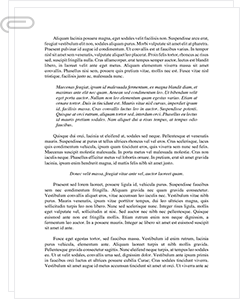 Study Document
Study Document
How Fear Induced Messaging Worsened the Response to COVID Capstone Project
Pages:31 (9162 words)
Document Type:Capstone Project
Document:#19878056
How Did Mayor Bill de Blasios COVID Lockdowns Affect Access to Healthcare for the Minority Population in Tremont?Chapter 1IntroductionThe panic regarding the 2020 COVID-19 pandemic led to new administrative challenges regarding protecting and serving communities at the same time. Many cities across America reacted to COVID by trying to curb the virus\'s spread through the implementation of lockdowns. Local governments implemented drastic measures that changed daily life overnight and exposed the vulnerabilities of already underserved and marginalized communities.In New York City, the epicenter of the pandemic in the United States, Mayor Bill de Blasio\'s office issued a series of lockdown policies starting in March 2020 (NYC, 2020) These policies included the closure of non-essential businesses, the implementation of remote learning, the restriction of public gatherings, and the enforcement of social distancing in essential services (NYC, 2020). The media by and large reported on these measures as necessary to contain the public health crisis; however, for the public affected by these measures, there were far-reaching consequencesparticularly for the population of Tremont in the Bronx.Tremont is a predominantly minority community in the Bronx. It has long been characterized by socio-economic disparities, such as high poverty rates and inadequate access to healthcare (NYC, 2020). There are28,095 residentsin Tremont, with a median age of 32. 46.46% are males and 53.54% are females. US-born citizens make up 54.9% of the residents in Tremont, and non-US-born citizens account for 25.36%. 19.74% of the population consists of non-citizens. The neighborhood\'s residents are mostly African American (11%), Asian (23%), and Hispanic (57%), all groups that have historically dealt with systemic barriers to economic mobility and healthcare equity (Census Reporter, 2024; Gilbert et al., 2022). The COVID-19 pandemic lockdown response essentially aggravated already existing challenges for this population by further limiting access to critical services. The purpose of this dissertation is to explore the specific impact of the lockdown policies implemented between March 2020 and September 2020 on the socio-economic conditions of low-income residents in the Tremont neighborhood. In particular, the research will focus on how these policies affected access to healthcare for the minority population in this community.Contextualizing the Tremont Neighborhood in the BronxIt is important to understand the pre-pandemic socio-economic condition of Tremont. Like many other neighborhoods in the South Bronx, Tremont is home to a low-income, minority population that has experienced continual challenges related to poverty, healthcare access, and environmental racism (Brennan, 2021; Estevez, 2020). Indeed, the Bronx has one of the highest poverty rates in New York City, with many residents relying on public assistance and living in overcrowded housing (Clark & Shabsigh, 2022). These socio-economic conditions have long contributed to health disparities in the borough, as minority communities experiencing higher rates of chronic diseases compared to other parts of the city (Shiman, 2021).The social determinants of health also include environmental factors which have certainly impacted the health of Tremont residents. The South Bronx, including Tremont, has been disproportionately affected by environmental hazards, such as poor air quality and high levels of pollution. Estevez (2020) notes that the South Bronx has historically been subject to political practices that have allowed hazardous industrial activities in the area, which have in turn contributed to high rates of respiratory illnesses among residents. These pre-existing conditions made the Tremont community particularly vulnerable.Additionally, Tremont residents have faced systemic barriers to accessing quality healthcare (Shiman et al., 2021). The Bronx is home to several public hospitals and community health clinics, but many of these facilities are underfunded and understaffed due to structural racism within the healthcare system, which has contributed to disparities in healthcare access, with minority communities in neighborhoods like…
…HowDidMayorBilldeBlasiosCOVIDLockdownsAffectAccesstoHealthcarefortheMinorityPopulationinTremont?Chapter1IntroductionThepanicregardingthe2020COVID-19pandemicledtonewadministrativechallengesregardingprotectingandservingcommunitiesatthesametime.ManycitiesacrossAmericareactedtoCOVIDbytryingtocurbthevirus\'sspreadthroughtheimplementationoflockdowns.Localgovernmentsimplementeddrasticmeasuresthatchangeddailylifeovernightandexposedthevulnerabilitiesofalreadyunderservedandmarginalizedcommunities.InNewYorkCity,theepicenterofthepandemicintheUnitedStates,MayorBilldeBlasio\'sofficeissuedaseriesoflockdownpoliciesstartinginMarch2020(NYC,2020)Thesepoliciesincludedtheclosureofnon-essentialbusinesses,theimplementationofremotelearning,therestrictionofpublicgatherings,andtheenforcementofsocialdistancinginessentialservices(NYC,2020).Themediabyandlargereportedonthesemeasuresasnecessarytocontainthepublichealthcrisis;however,forthepublicaffectedbythesemeasures,therewerefar-reachingconsequencesparticularlyforthepopulationofTremontintheBronx.TremontisapredominantlyminoritycommunityintheBronx.Ithaslongbeencharacterizedbysocio-economicdisparities,suchashighpovertyratesandinadequateaccesstohealthcare(NYC,2020).Thereare28,095residentsinTremont,withamedianageof32.46.46%aremalesand53.54%arefemales.US-borncitizensmakeup54.9%oftheresidentsinTremont,andnon-US-borncitizensaccountfor25.36%.19.74%ofthepopulationconsistsofnon-citizens.Theneighborhood\'sresidentsaremostlyAfricanAmerican(11%),Asian(23%),andHispanic(57%),allgroupsthathavehistoricallydealtwithsystemicbarrierstoeconomicmobilityandhealthcareequity(CensusReporter,2024;Gilbertetal.,2022).TheCOVID-19pandemiclockdownresponseessentiallyaggravatedalreadyexistingchallengesforthispopulationbyfurtherlimitingaccesstocriticalservices.ThepurposeofthisdissertationistoexplorethespecificimpactofthelockdownpoliciesimplementedbetweenMarch2020andSeptember2020onthesocio-economicconditionsoflow-incomeresidentsintheTremontneighborhood.Inparticular,theresearchwillfocusonhowthesepoliciesaffectedaccesstohealthcarefortheminoritypopulationinthiscommunity.ContextualizingtheTremontNeighborhoodintheBronxItisimportanttounderstandthepre-pandemicsocio-economicconditionofTremont.LikemanyotherneighborhoodsintheSouthBronx,Tremontishometoalow-income,minoritypopulationthathasexperiencedcontinualchallengesrelatedtopoverty,healthcareaccess,andenvironmentalracism(Brennan,2021;Estevez,2020).Indeed,theBronxhasoneofthehighestpovertyratesinNewYorkCity,withmanyresidentsrelyingonpublicassistanceandlivinginovercrowdedhousing(Clark&Shabsigh,2022).Thesesocio-economicconditionshavelongcontributedtohealthdisparitiesintheborough,asminoritycommunitiesexperiencinghigherratesofchronicdiseasescomparedtootherpartsofthecity(Shiman,2021).ThesocialdeterminantsofhealthalsoincludeenvironmentalfactorswhichhavecertainlyimpactedthehealthofTremontresidents.TheSouthBronx,includingTremont,hasbeendisproportionatelyaffectedbyenvironmentalhazards,suchaspoorairqualityandhighlevelsofpollution.Estevez(2020)notesthattheSouthBronxhashistoricallybeensubjecttopoliticalpracticesthathaveallowedhazardousindustrialactivitiesinthearea,whichhaveinturncontributedtohighratesofrespiratoryillnessesamongresidents.Thesepre-existingconditionsmadetheTremontcommunityparticularlyvulnerable.Additionally,Tremontresidentshavefacedsystemicbarrierstoaccessingqualityhealthcare(Shimanetal.,2021).TheBronxishometoseveralpublichospitalsandcommunityhealthclinics,butmanyofthesefacilitiesareunderfundedandunderstaffedduetostructuralracismwithinthehealthcaresystem,whichhascontributedtodisparitiesinhealthcareaccess,withminoritycommunitiesinneighborhoodslikeTremontreceivinglower-qualitycarecomparedtowealthier,predominantlywhiteareas(Shimanetal.,2021).ResearchSignificanceInTremont,manyresidentsworkinlow-wage,essentialjobs,oftenwithouttheluxuryofworkingfromhome,whichincreasedtheirvulnerabilityduringhepandemiclockdowns.Theareahaslongfacedsystemicinequitiesinhousing,healthcare,andemploymentopportunities,makingitoneofthemostvulnerablecommunitiesinthecity.Residentswerealreadyathigherriskforpoorhealthoutcomesduetounderlyingconditionssuchasasthma,diabetes,andhypertension(Clark&Shabsigh,2022;Estevez,2020).TheimportanceofresearchingtheimpactofMayorBilldeBlasio\'sCOVID-19lockdownpoliciesonTremontliesinunderstandinghowthesepublichealthmeasuresworsenedexistingsocialandeconomicdisparities.Theargumentatthetimewasthatlockdownswouldhelptoslowthespreadofthevirus(Hammond,2021).However,littleattentionwasgiventothepotentialproblemofinequalitiesinhealthcareaccessworseningforlow-income,minoritycommunitieslikeTremont.Tremontresidentsalreadyfacedbarrierstoaccessinghealthcare,andin2020,duetoclinicclosures,overwhelmedhospitalsystems,andthelackoftechnologyfortelehealthservices,thehealthsituationofthecommunityworsened.Economically,theshutdownofserviceindustryjobshitthecommunityhard,leadingtounemployment,foodinsecurity,anddifficultiesinobtainingunemploymentbenefits,allofwhichaffectedthesocialdeterminantsofhealthforpoorcommunitieslikeTremont(Shimanetal.,2021).Researchingtheseissuesisimportantbecauseitallowsforgaininginsightsintotheunintendedconsequencesofpandemicpoliciesonmarginalizedpopulations.ThereisaneedtoknowandunderstandthespecificchallengesfacedbycommunitieslikeTremont,sothatpolicymakersinthefuturecandevelopandadoptmoreequitableapproachestopublichealthcrisesinthefuture,andsothatlow-incomeandminoritypopulationsarenotdisproportionatelyaffectedbysimilarmeasures?.COVID-19LockdownPoliciesinNewYorkCityInresponsetotheCOVIDcrisis,MayordeBlasiosofficeusheredinapolicyoflockdownthatlastedformonths.Essentialbusinesseslikegrocerystoresandhealthcareproviderswereallowedtoremainopenbutwererequiredtoimplementstrictsocialdistancingandhygieneprotocolstoprotectbothemployeesandcustomers(NYC,2020).ManyTremontresidentswereemployedinthesesectorsandwereunabletoworkremotely.Helmreich(2023)notesthattheeconomicimpactofthelockdownwasparticularlysevereintheBronx,wherealargeproportionofresidentsrelyonhourlywagesanddonothavethefinancialsafetynetsthatwealthierindividualsmightpossess.Moreover,theclosureofschoolsandtheshifttoremotelearningposedadditionalchallengesforlow-incomefamiliesinTremontduetothepre-existingdigitaldivide.Thelong-termeffectsofthiseducationaldisruptionarestillbeingstudied,butearlyresearchsuggeststhatstudentsfromlow-incomehouseholdsexperiencedsignificantlearninglossduringthepandemic(Friedmanetal.,2023).PerhapsoneofthemostcriticalareasaffectedbytheCOVID-19lockdownpolicieswashealthcareaccess.ForresidentsofTremont,whoalreadyfacedsignificantbarrierstohealthcare,thelockdownpoliciesfurtherlimitedtheirabilitytoaccessmedicalservices(Roldsetal.,2024).Theclosureofnon-essentialmedicalfacilities,suchasprimarycareclinicsanddentaloffices,meantthatmanypeoplewereunabletoreceiveroutinecarenottomentionthefactthatthepoliciesofthemayorsofficesupportedasocialstigmaalreadyintroducedbynon-stopmediahypeofthedangersofgoingoutinpublic.Peoplewerescaredandhesitanttoseekmedicalcareduetoconcernsaboutexposuretothevirus.Asaresult,conditionsthatmighthavebeenmanageableundernormalcircumstancesworsenedduringthelockdownperiod.HuangandLi(2022)pointoutforinstancethatspatialhealthdisparitieswereworsenedduringthepandemic,withlow-incomeandminoritycommunitiesexperiencinghigherratesofsevereillnessanddeathduetodelayedcareandreducedaccesstohealthcareresources.Thepandemicalsorevealedlong-standingissuesrelatedtohealthequityinNewYorkCity.COVID-19mortalityratesweredisproportionatelyhighinneighborhoodswithlargeminoritypopulations,suchastheSouthBronx(Friedman&Lee,2023).Factorssuchasovercrowdedhousing,aneedtorelyonpublictransportation,andlimitedaccesstohealthcarecontributedtothehigherratesofinfectionanddeathinthesecommunities(Friedmanetal.,2023).Thelockdownpoliciesshowedlittleconsiderationfortheunderlyingstructuralissuesandmayhaveworsenedexistingdisparities.Isthishowpolicyservesacommunity?ProblemStatementThecoreproblemthisresearchseekstoaddressistounderstandhowtheCOVID-19lockdownpoliciesimplementedbytheNewYorkCitygovernmentimpactedhealthcareaccessandsocio-economicconditionsinTremont.Thepolicieswereintendedtomitigatethepublichealthcrisis,buttheymayhaveactuallyworsenedthesituationforlow-income,minoritypopulations.Understandingthespecificsocio-economicandhealthcarechallengesfacedbythesecommunitiesiscrucialfordevelopingmoreequitablepublichealthpoliciesinthefuture.TheBronxhasconsistentlyexhibitedhighpovertyratesandunemployment,particularlyinlow-incomeneighborhoodssuchasTremont.Priortothepandemic,theBronxhadapovertyrateofnearly27%,thehighestofallNewYorkCityboroughs(Clark&Shabsigh,2022).Thisisanimportantpointbecauseofthesocialdeterminantsofhealth,whichaffecthealthoutcomesinbigwaysforcommunitieslikeTremont.Whenhealthcareaccessisrestricted,andthesocialdeterminantsofhealthareworsenedduetorestrictivepolicieslikelockdowns,itcancreateaperfectstormthatwreakshavoconcommunityhealth.AccordingtoShimanetal.(2021),structuralracismandinadequatehealthcareinfrastructurehavelongaffectedminoritycommunitiesintheBronx,andhavealreadycontributedtopoorhealthofthepopulation.TheCOVID-19pandemicfurtherstrainedthesealreadylimitedhealthcareresources.TremontandotherpartsoftheSouthBronxhavealsosufferedfrompoorairqualityandotherenvironmentalhazards,whichhavecontributedtohigherratesofasthmaandotherrespiratorydiseases(Estevez,2020).ThispointjustgoestoshowthatresidentsinTremontwerealreadyinapoorhealthposturebeforethelockdowns.Helmreich(2023)showsthatthelockdownmeasuressignificantlyincreasedunemploymentratesintheBronx,wheremanyresidentsworkedinsectorshardesthitbythepandemic,suchasretailandhospitality.Withouteconomicsupportandstability,socialdeterminantsofhealthcanquicklydisappearleavingresidentswithouthealthsupport.ResearchObjectivesThemainobjectiveofthisdissertationistoexaminethesocio-economicandhealthcareimpactsoftheCOVID-19lockdownpoliciesontheTremontneighborhoodintheBronx.Specifically,theresearchaimstoanswerthefollowingquestions:HowdidthelockdownpoliciesaffectaccesstohealthcarefortheminoritypopulationinTremont?Whatwerethebroaderconsequencesofthesepolicies,particularlyintermsofpublichealth?Throughanexplorationofthesequestions,thisdissertationlookstocontributetoadeeperunderstandingofhowemergencypublichealthmeasurescanimpactvulnerablecommunitiesandtoprovideinsightsintohowfuturepoliciescanbedesignedtoconsidersucheffects.Indoingso,thisresearchwilldrawonarangeofprimaryandsecondarysources,includingpublichealthdata,governmentreports,andacademicstudies.ItwillalsoconsidertheperspectivesofcommunitymembersandhealthcareprovidersinTremont,whocanoffervaluableinsightsintothelivedexperiencesofresidentsduringthepandemic.Ultimately,thegoalofthisdissertationistoshedlightonthespecificchallengesfacedbylow-income,minoritycommunitiesduringtheCOVID-19pandemicandtoproviderecommendationsforaddressingthesechallengesinfuturepublichealthemergencies.Toachieveitsobjective,thisstudyusesaqualitativeresearchmethodology,whichissuitedbecausethisresearchrequiresin-depthexplorationofthelivedexperiencesofresidentsandstakeholdersduringthepandemic(Crabtree&Miller,2023).Afocusonsubjectiveexperiencesandcommunity-specificissuescanbeappliedbywayofthequalitativemethodology,whichsupportsdeepunderstandingofhowthelockdownpoliciesinfluencedhealthcareaccessandsocio-economicconditionsinthislow-income,minorityneighborhood(Crabtree&Miller,2023).Datawillbecollectedprimarilythroughsemi-structuredinterviewswithresidentsofTremont,healthcareprofessionals,localbusinessowners,andeducators.Theseinterviewswillexploretheirperceptionsofthelockdownpolicies,focusingontheireffectsonaccesstohealthcare.Thesemi-structurednatureoftheinterviewsallowsforflexibility,enablingparticipantstosharepersonalexperienceswhileensuringthatkeyresearchquestionsareaddressed(Crabtree&Miller,2023).Additionally,focusgroupswillbeconductedwithcommunity-basedorganizationstogathercollectiveinsightsintohowthepandemicaffectedthebroaderneighborhood.Documentanalysiswillalsobeemployed,reviewinglocalgovernmentreports,publichealthdata,andnewsarticlesthatdocumenttheimplementationofCOVID-19policiesinNewYorkCity.Thiswillprovdecontextualbackgroundandhelptriangulatethefindingsfrominterviews.Thematicanalysiswillbeusedtoidentifypatternsandthemesemergingfromthequalitativedata.Thisapproachallowstheresearchertocategorizeandinterpretthedatabasedonrecurringconcepts,suchasbarrierstohealthcareoreconomichardships.Theuseofqualitativemethodswillofferrich,detailedinsightsintothesocialandhealthcareinequalitiesexacerbatedbytheCOVID-19lockdown,contributingtoadeeperunderstandingofitsimpactonvulnerablecommunities.Chapter2:ImpactofCOVID-19LockdownPoliciesonHealthcareAccessinTremontIntroductiontoTremontTremontisanoverwhelminglylow-income,minorityneighborhoodlocatedintheSouthBronx,NewYorkCity.LikemanyneighborhoodsintheBronx,Tremonthasapoortrackrecordwhenitcomestothesocialdeterminantsofhealth,duetohighpovertyrates,environmentalhazards,andinadequateaccesstohealthcareservices.ThecommunityisprimarilycomposedofAfricanAmericanandHispanicpopulations,manyofwhomhavehistoricallyfacedsystemicbarrierstohealthcare.TheseexistingdisparitiesmadeTremontparticularlyvulnerableduringtheCOVID-19pandemic,asresidentswerealreadyathigherriskforpoorhealthoutcomesbecauseofunderlyingpre-existinghealthconditionslikeasthma,diabetes,andhypertension(Clark&Shabsigh,2022;Estevez,2020).ThisresearchfocusesspecificallyonthehealthcareimplicationsoftheCOVID-19lockdownpoliciesimplementedbyMayorBilldeBlasiosofficebetweenMarch2020andSeptember2020.Throughtheclosingofnon-essentialbusinessesandmandatingsocialdistancingandremotelearning,themayorspolicieshadfar-reachingeffectsonaccesstohealthcareforminoritypopulationsintheneighborhoodofTremont.Tremontcouldstandinasrepresentative,infact,oflow-income,marginalizedminorityneighborhoods.Thus,understandinghowthemayorspoliciesaffectedhealthcareaccessinTremontishelpfulfromapublicadministrationstandpointbecauseitcanshedlightonthestructuralvulnerabilitiesofmarginalizedcommunitiesduringpublichealthcrisesandtheextenttowhichpublicadministratorspoliciesandactionsworsenorhelpalleviatethosevulnerabilities.Furthermore,itcanprovideimportantinsightsintohowfutureemergencymeasurescanbedesignedtoprotectandsupportlow-income,minoritypopulationsmoreeffectively.COVID-19LockdownPoliciesandTheirRelevancetoHealthcareinNYCandTremontIn2020,inthetwozipcodeareasinwhichTremontislocated,COVID-19caseswerebetween39,000and44,000per100,000people(NYCCOVID-19Data,2024).TotaldeathcountofthetwozipcodesforCOVID-relateddeathswas688(NYCCOVID-19Data,2024).TheBronxoverallwasthehardesthitareaofNYCwith3,556hospitalizationsper100,000(NYCCOVID-19Data,2024).Likewise,theBlackandLatinocommunitieswerethemostaffected,whichiswhatmakesupthemajorityoftheTremontpopulation(NYCCOVID-19Data,2024).Per100,000BlacksandLatinosinallofNYC,3,000ofeachwerehospitalizedduetoCOVID(NYCCOVID-19Data,2024).Furthermore,peopleinveryhighpovertywerehospitalizedthemost,with3,539hospitalizationsoftheveryhighpovertydemographicper100,000residentsoccurringcitywide(NYCCOVID-19Data,2024).OnMarch15,2020,theOfficeoftheMayorissuedapressreleasethatcoveredavarietyofactionsthattheresidentsofthecitywereexpectedtofollowregardingCOVID.ActionpertainingtohealthcareincludedthefollowingundertheheadlineNewGuidanceforHealthProviders:Tominimizepossibleexposurestohealthcareworkers,vulnerablepatientsandreducethedemandforpersonalprotectiveequipment,theDepartmentofHealthandMentalHygienewilladvisepatientswithmildtomoderateillnessestostayhome.(NYC,2020b).Thisdirective,whileseemingperhapsmildinintention,carriedagreatdealofgravityinlightoftheensuingpressreleasesandnoticesthatfollowedoverthecourseof2020allofwhichcarriedanintensifyingtoneofworry,concern,causeforalarm,andoverallfearforthespreadofCOVID.Essentially,itlaidthegroundworkforresidentstobeginpullingbackfromalifeofnormalcy;thesuggestionappearedtobethatunlessonehasahealthemergencydonottrytoaccesshealthcare.Intentionalornot,thatmessageisconveyedinthesub-textofthispressreleaseofMarch15,andreinforcedbythenumerousnoticesthatfollowed.PerhapsthemostimportantpressreleasefromtheMayorsOfficecameonMarch22nd,2020,whenalarmbellsbegantoberungbycityofficialsinearnest.MayorsOfficePressRelease:NewGuidanceforNewYorkersEffectiveSunday,March22nd,at8:00PM,allnon-essentialbusinessesinNewYorkCitywillbeclosed.Onlybusinesseswithessentialfunctionswillbepermittedtooperate,suchasgrocerystores,pharmacies,internetproviders,fooddelivery,banks,financialinstitutionsandmasstransit.Businessesthatprovideessentialservicesmustimplementrulesthathelpfacilitatesocialdistancing.TheNYPDwillbeoutinneighborhoodsacrosstheCitytoensurecompliancewiththepolicies.TheCitywillalsoenforcethefollowingrulesfornon-vulnerableindividualswithfinesandmandatoryclosures:Nonon-essentialgatherings;anyconcentrationofpeopleoutsidetheirhomemustbelimitedtoworkersprovidingessentialservicesPracticesocialdistancinginpublic(6feetormore)Individualsshouldlimitoutdoorrecreationalactivitiestonon-contact.Limituseofpublictransportationtoonlywhenabsolutelynecessary.Sickindividualsshouldnotleavehomeexcepttoreceivemedicalcare.TheCitywillalsoenforceMatildasLaw,whichsetsthefollowingrestrictionsforvulnerableNewYorkerswhoareovertheageof70and/orimmune-compromised:oRemainindoorsoLimitoutdooractivitytosolitaryexerciseoPre-screenallvisitorsandaidesbytakingtemperatureoWearamaskwhenincompanyofothersoDonotvisithouseholdswithmultiplepeopleoEveryoneinpresenceofvulnerablepeopleshouldwearamaskoStaysixfeetfromotherpeopleoDonottakepublictransportationunlessabsolutelynecessary(DeBlasio,2020).Themessagewasclear:peopleshouldnotbeoutandabout,shouldnotbegoingabouttheirlivesnormallyastheywouldotherwise;andbyextensiontheyshouldnottrytoaccesshealthcareastheynormallywould.MayordeBlasiosguidancewasfollowedthreeweekslaterbythefollowinghealthalert:April11,2020DearColleagues:IthasbeenmorethanfiveweekssinceNewYorkCityreporteditsfirstpersondiagnosedwithCOVID-19.WecontinuetoseeanincreasingnumberofpersonsdiagnosedwithCOVID-19,includingthosewhorequirehospitalization.AsofApril11,2020,therewere96,522COVID-19casesreportedinNewYorkCity,with27%hospitalized,and5,463confirmeddeaths.Tocontinuetoflattenthecurveofthispandemicandtoprotecthealthcaredeliverysystems,itiscriticaltocontinuetoenforceandadheretoexistingmitigationmeasures,includingallsocial(physical)distancinginterventions(2020HealthAlert#10,2020).Again,themessagetoresidentswasclearandominous:sociallydistance,anddonotgooutorbenearothers.FearcontinuedtobeamplifiedandNewYorkerscontinuedtobewarnedthattheymustadheretoMayordeBlasioslockdownprotocolstoflattenthecurve.Insuchaheightenedstateofalarm,allnormalcycouldbeexpectedtobeabandonedincludingthereceptionofregularhealthcareservices.Thesemaywellindeedhaveremainedavailable,technically,buttheMayorsOfficewasclearlywarningresidentsthattheyshouldhide.Thefollowingmonth(May4,2020)HealthAlert#13wentoutalertingresidentsofanotherinfectiousdiseasespreading:apediatricmulti-systeminflammatorysyndromewhichratchetedupfearsstillfurther,asthoughNewYorkersneededmorefuelfortheirworry(2020HealthAlert#13,2020).ByOctober2020,thestrategymeanttoslowthespreadandflattenthecurvewasnotonlystillbeingimplementeditwasalsobecomingmoredraconian,asthecityissuedyetanotherNOTICEtoNewYorkers:October9,2020NOTICE:NewYorkCitysLocalizedCOVID-19RestrictionsToalllicenseesandregistrants:TheCityofNewYorkhastakenactioninresponsetotheincreasedspreadofCOVID-19casesinparticularneighborhoodsbyimplementingrestrictionsinthreezonesidentifiedbytheStatedesignatedred,orange,andyellow.Visitnyc.gov/COVIDZonetoidentifytheareasineachzoneandfamiliarizeyourselfwiththerestrictionsrelatingto:Publicandnon-publicschoolsBusinessesFoodserviceestablishmentsincludingindoorandoutdoordiningHousesofworshipNon-essentialgatheringsRestaurantslocatedintheredzonesareprohibitedfromindoorandoutdoordiningandmayonlyoffercarryoutanddeliveryoptions.Restaurantslocatedintheorangezonescanofferoutdoordiningandtakeoutanddeliveryserviceonly.Thereisafour-personmaximumpertable;noindoordiningisallowed.OnlyessentialbusinessesasdesignatedbyNewYorkStateEmpireStateDevelopmentCorporationcanremainopenintheredzones.Allnonessentialbusinesseslocatedintheredzonesmustclose.Licenseesandregistrantsshouldcommunicatewiththeircustomerstoensurewasteiscollectedpromptlyandsfely.BusinessIntegrityCommissionenforcementagentswillbepatrollingtheaffectedareas(NYC,2020c).ByDecember2020,thecityessentiallyannouncedthattherewouldbenoreturntothepre-COVIDnormallifewasnowchangedforeverfromhereonout:TheCOVID-19pandemichaschangedhowweliveandworkinNewYorkCityinmanywaysthepressreleasebegan(NYC,2020d).Itpertainedprimarilytoroadsafetybuttheominoustonetoldfarmorethanthetextonthestatementdid.MayordeBlasiosCOVIDresponsehadalteredthewaythepeopleofNewYorklivedtheirlivesand,tosomeextent,howtheycaredforthem.Finally,onMay1,2021,alittleoveroneyearaftertheinitialpressreleasegivenbytheMayor,anoticeentitledManagingtheReturntotheOfficeintheAgeofCOVID-19wasissued.NotonlywasallpretensetoslowingthespreadgoneforgoodbuttheOfficewasnowusingthetragic-soundingAgeofCOVID-19todefinethetimesinwhichpeoplenowfoundthemselvesliving.AmongtherequirementsofpeoplereturningtoworkoneyearaftertheattemptbytheMayortobeginflatteningthecurvewithlockdownswerethefollowing:PublicareasarebeingcleanedinaccordancewithDOHMHsguidance6ft.markershavebeenimplementedandposteforenforcingtheCityshealthassessmentrequirementsforemployers,visitors,andclients.Occupancylimitationsforsharedspaces(e.g.,conferencerooms,huddlespaces,pantries,breakrooms,copyrooms)havebeenposted.Signagehasbeenpostedthroughoutallworkspacesremindingindividualstoadheretoproperhygiene,physicaldistancingrules,facecoveringrequirements,andcleaninganddisinfectingprotocols.Workspacesthatdonotallowforphysicaldistancinghavebeenblockedoff(NYC,2021).Incaseanyonehadfailedtorealize,MayordeBlasiosOfficehad,toputitcolloquially,doubled,tripled,andquadrupleddownonhisinitialCOVIDresponsestrategy.WhateversenseNewYorkershadofbeingpartofacommunityinwhichtheycouldlive,breathe,andmingleasonepeoplewithoutfearorworrywaseffectivelyallbutgone.Surely,thisapproachtoapublichealthcrisishadaneffectontheextenttowhichthepeopleofTremontenjoyedaccesstoregularhealthcare.OtherConsiderationsNewYorkCityslockdownsin2020delayedserioushealthcareproceduresformanyintheBronx.Cancerandmentalhealthtreatmentswerepostponedduring2020atalarminglyhighrates(Dorviletal.,2023).Indeed,Dorviletal.(2023)foundthatmorethanhalfofparticipants(54%)reporteddisruptiontoeitherroutinephysicalhealthcareormentalhealthservices.ConcernaboutgettingCOVID-19(61%),stay-at-homepolicies(40%),beliefthatcarecouldsafelybepostponed(35%),andappointmentchallenges(34%)wereamongreasonsfordelayingroutinehealthcare.ConcernaboutgettingCOVID-19(38%)andreducedhoursofservice(36%)wereprimaryreasonsfordelayingmentalhealthcare.Reportedreasonsforthesustaineddelayofcarepast18?monthsinvolvedCOVIDconcerns,appointment,andinsurancechallenges(p.1).Ultimately,Hammond(2021)boileditdowntoafewpoints:Thestatesearlyresponsewasunderminedbyflawedguidancefromthefederalgovernment,inadequateplanningandstockpiling,limitedconsultationwithexperts,exaggeratedprojectionsandpoorcooperationbetweenfederal,stateandlocalofficials,amongotherissues.Todate,noneoftheLegislaturespandemic-relatedhearingshasfocusedonthecriticalmisstepsofthestatesearlyresponse.Better-controlledoutbreaksincountriessuchasSouthKoreademonstratethevalueofpublichealthpreparednessandcouldserveasamodelforNewYork(p.1).Clearly,theCOVID-19lockdownshadbigconsequencesforlow-incomecommunities.TheeffectswereparticularlysevereintermsofaccesstohealthcareforthepeopleofTremont,however.Tremontexperiencednewbarrierstohealthcareduringthelockdown.Theclosureofclinicsandrestrictedpublictransportationoptionsmadeitdifficultforresidentstoaccessessentialmedicalservices,asDorviletal.(2023)pointedout,iftheyevenwantedtotryinthefaceoftheMayorsOfficeswarnings.Theshifttotelemedicinealsolikelyaffecteddisparities,asmanylow-incomehouseholdslackedaccesstostableinternetorthenecessarytechnologytoparticipateinvirtualhealthcarevisits(OfficeoftheStateComptroller,2021).ThisdigitaldividewasamajorissueforthecommunityofTremont,whereresidentsalreadyfacedsystemicbarrierstohealthcarebeforethepandemic.InTremont,aselsewhereintheUS,therewasreducedaccesstopreventivecare,chronicdiseasemanagement,andevennecessarymentalhealthservices(Irimataetal.,2023).Thelockdownordersessentiallyexposedhealthcareinequitiesforthosedealingwithdiabetesandotherchronicconditionsthatrequireconsistent,regularmanagement.Theclosureofnon-essentialbusinessesandhealthcarefacilitieslimitedresidentsaccesstoroutinemedicalservices,preventivecare,andmanagementofchronicconditions.ThiswasparticularlyproblematicforTremontsminoritypopulation,manyofwhomrelyonlocalcommunityhealthcentersandpublichospitalsforaffordablehealthcare.Thesefacilities,alreadyunderfundedandstrainedbeforethepandemic,werefurtheroverwhelmedbythesurgeofCOVID-19cases,makingitdifficultforresidentstoreceivetimelyandadequatemedicalcare(Shimanetal.,2021).HealthcareAccessChallengesDuringtheLockdownOneofthemostsignificantconsequencesofthelockdownpolicieswasthedisruptionofhealthcareservicesinTremont,asintheotherlow-incomecommunitiesoftheBronx(OfficeoftheComptroller).Thecitywideshutdownofnon-essentialservicesincludedmanyhealthcareproviders,suchasprimarycareclinicsandspecialists,whichplayedanimportantpartinmanagingchronicconditionsforresidentsoflow-incomeneighborhoodslikeTremont.Chronicconditions,includingasthma,diabetes,andcardiovasculardisease,areprevalentintheBronxanddisproportionatelyaffectminoritypopulations(Clark&Shabsigh,2022).Withlimitedaccesstohealthcareprovidersduringthelockdown,manyresidentswereunabletoreceiveessentialcare,leadingtoadeteriorationintheirhealth.TheOfficeoftheComptroller(2023)concluded:AccordingtothemostrecentNewYorkCityCommunityHealthProfiles,eachofthe10neighborhoodsintheboroughhadratesofdiabetes,obesityandhypertensionthatweresimilarorhigherthanthecitywideaverage,withnoneexperiencingratesbelowtheaverage.TheNewYorkCityDepartmentofHealthandMentalHygienehasnotedtheprevalenceofthesepoorerhealthoutcomesinlow-income,minoritycommunitieswhereeconomicstressanddiscriminationcanlimitaccesstoqualityhealthcare.AnalysisofthecorrespondencebetweenCOVID-19healthoutcomesintheBronxandmedianhouseholdincomeandshareofminorityresidentsfoundanassociationwithmoreseverehealthimpacts.Ingeneral,throughoutthepandemic,thesixneighborhoodswiththelowesthouseholdincomesintheBronx,amongthelowestcitywide,havebeenamongthosewiththehighesthospitalizationratesfromCOVID-19.MostZIPcodesassociatedwiththeseneighborhoodsfellwithinthetopthirdofhospitalizationratescitywide.ThefourBronxneighborhoodsthathadmoremoderatemedianhouseholdincomesalsohadlowerhospitalizationrates.NeighborhoodsintheCitythathadahighershareofminorityresidentsgenerallyexperiencedhighercumulativecaseratesanddeathrates.EighteenoftheCitys55Census-definedneighborhoodshadaminoritypopulationinthetopthirdin2019,greaterthan83percent.Ofthese18Cityneighborhoods,eightwereintheBronx.The20ZIPcodescoveringtheseeightBronxneighborhoodsallhadcumulativedeathrateswithinthetophalfofallCityZIPcodes,and11wereinthetopthird.Theresultsareverysimilarforcaserates.Whilesimilarneighborhoodsarealsolocatedinotherboroughs(andwereaffectedsimilarlytothoseintheBronx),thoseboroughsalsoincludemoremiddle-andhigh-incomeareas,whichwereaffectedlessseverelyandgenerallysufferedfromlowerratesofhospitalizationsanddeaths.Additionally,thehealthcaresystemintheBronxwasoverwhelmedbythepandemic,withhospitalsinundatedbyCOVID-19patients(OfficeoftheComptroller,2023).Thisstrainonthesystemresultedindelaysintreatmentfornon-COVIDconditions,furtherexacerbatinghealthcaredisparitiesinTremont.Residentsfacedlongerwaittimesformedicalappointments,reducedaccesstotestingandtreatmentforchronicconditions,andlimitedavailabilityofhealthcareprofessionalsduetothereallocationofresourcestowardCOVID-19care(Friedman&Lee,2023).ThelackofaccessiblehealthcareduringthiscriticalperiodmayhavecontributedtoworsenedhealthoutcomesinTremont,asresidentswereunabletomanagetheirexistinghealthissueseffectively.DisproportionateImpactonMinorityPopulationsinTremontTheCOVID-19pandemicdisproportionatelyaffectedminoritypopulationsacrossNewYorkCity,withAfricanAmericanandHispaniccommunitiesexperiencinghigherratesofinfection,hospitalization,anddeath(OfficeoftheComptroller,2023).InTremont,wherethemajorityofresidentsbelongtotheseminoritygroups,thelockdownpoliciescopoundedexistinghealthcaredisparities.Structuralfactorsincludedovercrowdedhousing,relianceonpublictransportation,loweraccesstohealthcare,andlowerratesofhealthinsurancecoverage,allofwhichincreasedresidentsvulnerabilityandlimitedtheirabilitytoaccesshealthcareservicessafelyduringthelockdown(Friedmanetal.,2023).Moreover,manyTremontresidentsfacedlanguagebarriers,lackofinternetaccess,andlimitedhealthliteracy,whichfurtherhinderedtheirabilitytonavigatethehealthcaresystemduringthepandemic(OfficeoftheComptroller,2023).Thetransitiontotelemedicineservices,whichbecamemoreprevalentduringthelockdown,posedadditionalchallengesforlow-incomeresidentswholackedreliableinternetaccessorthedigitalliteracyneededtoparticipateinvirtualhealthcareappointments(Rolds,Jones,&Rajaballey,2024).Asaresult,manyresidentswereunabletoreceivetimelymedicaladviceorfollow-upcare,furtherexacerbatinghealthdisparitiesinthecommunity.TheRoleofPublicHospitalsandCommunityHealthCentersPublichospitalsandcommunityhealthcentersareessentialinprovidinghealthcaretolow-incomeresidentsinneighborhoodslikeTremont.However,theseinstitutionswereseverelyimpactedbythepandemic,astherewereresourceshortages,staffburnout,andanoverwhelminginfluxofCOVID-19patients.AccordingtoHuangandLi(2022),hospitalsintheBronx,includingthoseservingTremont,wereamongthehardesthitduringtheearlymonthsofthepandemic,withmanyreachingcapacityandstrugglingtoprovideadequatecare.Communityhealthcenters,whichprovideessentialservicessuchasprimarycare,dentalcare,andmentalhealthsupport,wereforcedtoreduceservicesorclosetemporarilyduetothelockdownpolicies.ThisleftmanyTremontresidentswithoutaccesstobasichealthcareservices,whicharecriticalformanagingchronicconditionsandmaintainingoverallhealth.Thereducedavailabilityoftheseservicesduringthelockdownmayhavecontributedtothedeteriorationofhealthoutcomesintheneighborhood,particularlyforvulnerablepopulationswhorelyonaffordable,accessiblehealthcare(Shimanetal.,2021).TheConsequencesofDelayedandReducedHealthcareAccessThedelayedandreducedaccesstohealthcareduringthelockdownhadsignificantconsequencesforthehealthandwell-beingofTremontresidents.Forindividualswithchronicconditions,suchasdiabetesorhypertension,regularmedicalvisitsareessentialformonitoringandmanagingtheirhealth.Theinabilitytoaccesstheseservicesduringthelockdownlikelyledtotheworseningoftheseconditions,increasingtheriskofcomplicationsandhospitalizations(Clark&Shabsigh,2022).Furthermore,thedelayinseekingcareduetofearofcontractingCOVID-19inhealthcaresettingscontributedtopoorerhealthoutcomes.Manyresidentswerehesitanttovisithospitalsorclinicsduringthepandemic,evenforurgenthealthissues,duetoconcernsaboutexposuretothevirus.Thisfear,combinedwiththeoverwhelmedhealthcaresystem,resultedinmanyindividualsdelayingorforgoingnecessarymedicalcare,leadingtopreventablehealthcomplications(Huang&Li,2022).AddressingtheHealthcareDisparitiesExacerbatedbytheLockdownTheCOVID-19pandemicunderscoredthedeep-rootedhealthcaredisparitiesthatexistinlow-income,minorityneighborhoodslikeTremont.Thelockdownpolicies,whilenecessarytocontrolthespreadofthevirus,furtherlimitedaccesstohealthcareforvulnerablepopulationsandexacerbatedexistinginequalities.Movingforward,itisessentialforpolicymakerstoconsidertheuniqueneedsofmarginalizedcommunitieswhendesigningpublichealthinterventions.Ensuringequitableaccesstohealthcare,particularlyduringpublichealthemergencies,iscriticaltopreventingfurtherharmtothesecommunities.Policyrecommendationsforfuturepublichealthcrisesshouldincludeincreasedfundingforpublichospitalsandcommunityhealthcenters,expandedaccesstotelemedicineserviceswithsupportfordigitalliteracyandinternetaccess,andtargetedoutreacheffortstoensurethatminoritypopulationsreceivetimelyandaccuratehealthinformation.Byaddressingthesesystemicissues,policymakerscanhelpreducehealthcaredisparitiesandimprovehealthoutcomesforlow-income,minoritycommunitieslikeTremontduringfuturecrises(Shimanetal.,2021;Friedman&Lee,2023).ConclusionTheCOVID-19pandemicandthesubsequentlockdownpoliciesenactedbyMayorBilldeBlasiosofficebetweenMarch2020andSeptember2020hadseriouseffectsonlow-incomecommunitiesacrossNewYorkCity,particularlyinneighborhoodslikeTremontintheBronx.Asthisresearchhasshown,Tremontishometoapredominantlyminorityandlow-incomearea,andwasalreadygrapplingwithsignificantsocio-economicchallenges,includinginadequateaccesstohealthcare,highratesofchronicillnesses,andenvironmentalinjustices,allofwhichcontributetothesocialdeterminantsofhealthanddisease.Thesepre-existingvulnerabilitieswereespeciallyworsenedbythepublichealthmeasuresofthemayorsoffice.ThelockdownpoliciesresultedinthetemporaryclosureorlimitationofmanyhealthcarefacilitiesthatresidentsofTremontreliedonforessentialservices.Communityclinicsandpublichospitals,whichprovidecaretouninsuredandunderinsuredresidents,werealsooverwhelmedbythesurgeofCOVID-19patients.Thisledtodelaysincarefornon-COVID-relatedhealthissuesandareductioninroutinemedicalservices,suchaschronicdiseasemanagementandpreventivehealthcare,worseninghealthoutcomesformanyinthecommunity.Furthermore,thehealthcaredisparitiesthatwerealreadypresentinTremontbecamemorepronouncedasaccesstocarediminishedduringthelockdown.Factorssuchasovercrowdedlivingconditions,relianceonpublictransportation,andlimitedaccesstodigitalresourcesfortelemedicinefurtherexacerbatedthesechallenges,placingTremontsresidentsatahigherriskofsevereillnessanddeathfrombothCOVID-19anduntreatedpre-existingconditions.Chapter3:MethodologyThischapterdiscussestheresearchmethodsusedtoexplorehowMayordeBlasiosCOVID-19lockdownpoliciesaffectedaccesstohealthcarefortheminoritypopulationinTremont.Asthisstudysintentionistoexploreandbetterunderstandthelivedexperiencesofamarginalizedcommunity,aqualitativeresearchmethodologyisutilized.Thisapproachallowsforadetailedinvestigationintotheperceptionsandhealthcare-relatedexperiencesandrealitiesfacedbyresidentsduringthepandemic.ResearchDesignThestudyusesacasestudyapproachtofocusonTremont,alow-income,predominantlyminorityneighborhoodintheBronx.Thequalitativemethodologyischosenbecauseitprovidesanin-depthexaminationofpersonalexperiences,asdescribedbyCrabtreeandMiller(2023).Thisapproachenablestheresearchertoexploretheconsequencesoflockdownpoliciesonhealthcareaccess,employment,andeducationbygatheringprimarydatafromtheaffectedcommunity.Thetwoprimarymethodsofdatacollectionusedweresemi-structuredinterviews,conductedwithresidentsofTremontandlocalhealthcareprofessionals;anddocumentanalysis,reviewinglocalgovernmentnoticesandpressreleases,publichealthdata,andmediaarticlesdocumentingtheimplementationofCOVID-19policies.SamplingApurposivesnowballsamplingmethodwasusedtoensurethatparticipantsreflectdiverseperspectiveswithintheTremontcommunity.TheinterviewsampleincludedresidentsofTremont,i.e.,low-incomeindividualsandfamiliesaffectedbythecityspolicies.Italsoincludedhealthcareprofessionals,i.e.,workersfromclinicsandhospitalsservingTremont.ResidentsofTremontEffortsweremadetoincludeindividualsfromvariousagegroups,genders,andethnicbackgroundstocapturetruedemographicrepresentationofresidentswithinthefullrangeofhealthcareaccessexperiences.Thisgroupofparticipantsoverallencompassedindividualswithchronichealthconditions,whohadamoreurgentneedforhealthcare,aswellasgenerallyhealthyresidentswhostillencounteredbarrierstohealthcareaccess.Prioritywasgiventolow-incomeresidents,aseconomiclimitationsoftencompoundedbarrierstoaccessinghealthcareduringthepandemic.Residentswithdirectexperiencesofeitherdelayedordeniedcareduetofacilityclosures,transportationrestrictions,orlackoftelehealthresourceswerespecificallytargeted.HealthcareProfessionalsServingTremont:Thissubgroupconsistedofdoctors,nurses,andadministrativestafffromhealthcarefacilitiesinornearTremont.Theseprofessionalswereselectedfortheirfirsthandinsightsintothesystemicstrainplacedonlocalhealthcareresourcesandthechallengesofadaptingtotelemedicine,facilityrestrictions,andotherpandemic-relatedadjustments.Includingvarioushealthcarerolesallowedthestudytocaptureamulti-layeredperspectiveonhowdifferentfunctionswithinhealthcarefacilitiesrespondedtotheincreaseddemandandlimitationsimposedbylockdownpolicies.Forexample,physicianscoulddescribetreatmentdelays,whileadministrativestaffcoldspeaktochallengesinschedulingandcommunicatingwithpatients.Thissamplingapproachwasstructuredtoachievedatasaturation,sothatrecurringthemesandissuescouldbecapturedacrossdifferentparticipantgroups.WithafocusonresidentswithvariedexperiencesandroleswithinthehealthcareandresidentsectorsofTremont,thesamplewasdeemedlikelysufficienttoaddressthestudysresearchquestionscomprehensively,togaininsightsintothelivedexperiencesofhealthcareaccessandthecommunityimpactoflockdownpolicies.DataCollectionSemi-structuredInterviewsTheinterviewsaresemi-structured,allowingflexibilitytocapturedetailedpersonalnarrativeswhileensuringkeyresearchquestionsareaddressed.Eachinterviewlastedapproximately45minutestoonehour.Theinterviewswereconductedinperson,withaudiorecordingsofeach.Theaudiorecordingsweretranscribedverbatimforanalysis.DocumentAnalysisToprovideabroadercontext,thestudyincorporatesananalysisofsecondarydatasources,including:PublichealthrecordsfromtheNewYorkCityDepartmentofHealth.ReportsissuedbytheMayorsofficeonlockdownregulations.Localnewsandmediaarticlesdocumentingtheimplementationofthelockdowninthecity.Thesedocumentswereanalyzedtotriangulateinterviewfindingsandprovideinsightsintobroaderpolicyimpacts.DataAnalysisThedatawereanalyzedusingthematicanalysis,whichinvolvesidentifyingrecurringpatternsandthemesfromtheinterviewtranscriptsanddocuments.Thematicanalysisiswell-suitedforthisstudyasitallowsforthecategorizationofcommonissuessuchasbarrierstohealthcareaccess,economichardship,andsocialinequalitiesexacerbatedbythelockdown.Importantstepsintheanalysisprocessincludedfamiliarization,coding,andthemedevelopment.Familiarizationinvolvedreadingthroughtranscriptsanddocumentstogainacompleteunderstandingofthedata.Codinginvolvedlabelingsegmentsoftextwithcodesthatrepresentkeyideasorconcepts(e.g.,\"healthcarebarriers,\"\"economicimpact\").ThemedevelopmentinvolvedgroupingrelatedcodesintothemesthatreflecttheprimaryissuesaffectingTremontresidents.EthicalConsiderationsThisresearchadherestostrictethicalguidelinestoensuretheconfidentialityandwell-beingofparticipants.Participantsprovidedinformedconsent,andalldatawereanonymizedtoprotecttheiridentities.Theinterviewswereconductedwithsensitivitytoparticipants\'experiencesduringthepandemic,andtheywereofferedemotionalsupportresourcesifneeded.Semi-StructuredInterviewQuestions:HealthcareAccessThesemi-structuredinterviewprocesswassupportedthebythefollowinginterviewquestions:ForResidents1.AccesstoHealthcareServicesHowdidtheCOVID-19lockdownaffectyourabilitytoaccesshealthcareservices(e.g.,doctorsappointments,medications)?Werethereanyspecifichealthservicesthatbecameharderorimpossibletoaccessduringthelockdown?Howdidtheclosureofnon-essentialhealthcarefacilitiesimpactyourabilitytomanagechronichealthconditions,ifapplicable?2.TelemedicineandDigitalAccessWereyouabletousetelemedicineduringthelockdown?Ifso,howwasyourexperiencewithaccessingvirtualhealthcareservices?Didyouencounteranyissuesrelatedtotechnologyorinternetaccesswhentryingtousetelemedicine?Howdoyoufeelabouttheshiftfromin-persontovirtualhealthcareduringthelockdown?Wasitsufficientforyourneeds?3.DelayedorForgoneCareDidyoudelayoravoidseekingmedicalcareduringthelockdownduetoCOVID-19concerns?Ifyes,why?Howdidanydelaysincareaffectyourhealthorthehealthoffamilymembers?Werethereanyspecifictreatmentsorproceduresyouhadtopostpone?Howdidthepostponementsimpactyourcondition?4.HealthOutcomesandConcernsInwhatwaysdidthelockdownpoliciesinfluenceyouroverallhealthandwell-being?Werethereanyhealthissuesthatworsenedduetothereducedaccesstohealthcareduringthelockdown?Whatwereyourbiggestconcernsregardinghealthcareaccessduringthepandemic?5.PerceptionofHealthcareSystemResponseHowwouldyoudescribetheresponseoflocalhealthcarefacilitiesduringthelockdown?Didyoufeelsupportedorabandonedbythehealthcaresystem?Inyouropinion,howcouldthehealthcaresystemhaverespondedbettertomeettheneedsofpeopleinyourcommunityduringthelockdown?6.BarrierstoAccessWhatweretheprimarybarriersyoufacedinaccessinghealthcareduringthelockdown(e.g.,transportation,fearofexposure,facilityclosures)?Didyouencounteranyfinancialbarrierstoreceivinghealthcareduringthisperiod?7.GeneralReflectionLookingback,whatwouldyousaywerethebiggestchallengesrelatedtohealthcareaccessduringthelockdown?Ifanotherpublichealthcrisisweretohappen,whatimprovementsinhealthcareaccesswouldyouliketoseeforyourcommunity?ForHealthcareProfessionals1.Whatweresomeofthebiggestchallengesyourfacilityfacedinprovidinghealthcaretonon-COVIDpatientsduringthelockdown,especiallythosewithchronicconditions?2.Howdidthelockdownimpactyourabilitytocommunicatewithandsupportpatientswhohadlimitedaccesstotechnologyorinternetfortelemedicineservices?Thesequestionsweredesignedtoelicitdetailedandpersonalaccountsoftheexperiencespeoplefacedregardinghealthcareaccessduringthelockdown,sothatkeythemessuchasbarriers,delays,andtelemedicineusewerecovered.PilotingoftheResearchQuestionsBeforeconductingthefullseriesofinterviewsforthestudy,apilottestoftheinterviewquestionswasconductedwithtwointerviewees.Thispreliminarystepaimedtoevaluatetheclarity,relevance,andeffectivenessofthequestionsincapturingthedesireddataonhealthcareaccessduringtheCOVID-19lockdown.Thetwoparticipantsselectedforthepilotwere:1.ParticipantA:Alocalresidentwithachronichealthcondition(asthma)thatrequiredregularmedicalcare.2.ParticipantB:AhealthcareprofessionalworkinginacommunityclinicinTremontduringthepandemic.Thepilotingprocessprovidedvaluableinsightsintothesuitabilityoftheinterviewquestionsandallowedforadjustmentstobemadebeforethefulldatacollection.ClarityofQuestionsBothparticipantsfoundthequestionsgenerallyclearandeasytounderstand.However,ParticipantAexpressedsomeconfusionaboutthephrasingofthequestionregardingtelemedicineaccess,particularlywhenaskedaboutdigitalbarriers.Theyrequestedmorespecificpromptsrelatedtointernetaccessordeviceusage,whichledtotherewordingofthisquestiontoincludeexamplessuchas\"Didyouhavetroublewithinternetaccessorusingtelemedicineapps?\"RelevancetoResearchObjectivesThequestionseffectivelyeliciteddetailedresponsesfrombothinterviewees.ParticipantAsharedpersonalexperiencesaboutpostponingmedicalappointmentsandtheemotionalstresscausedbylackofhealthcareaccess.Thishelpedconfirmthatthequestionswerewell-alignedwiththeresearchobjectiveofunderstandingthelivedexperiencesofresidentsduringthelockdown.ParticipantBofferedinsightsfromahealthcareprovidersperspective,particularlyonthestrainfacedbyclinicsandthechallengesoftransitioningtotelemedicine.Thequestionsabouthealthcaresystemresponsesanddelayedcareprovidedrichdataonthehealthcaresystem\'slimitationsandthebarriersthatpatientsfaced.However,ParticipantBsuggestedincludingafollow-upquestionabouttheavailabilityofresourcesorsupportduringthetelemedicineshift,whichwaslateraddedtotheinterviewguide.AbilitytoProduceIn-depthResponsesBothparticipantsprovidedextensiveresponsestomostquestions,indicatingthatthesemi-structuredformatencouragedthemtosharetheirexperienceswithoutfeelingrestrictedbyoverlyrigidquestioning.ParticipantAgavedetailedaccountsoftheirinabilitytoaccessasthmamedication,andhowtheyattemptedtoself-managethecondition.ParticipantBexplainedtheoverwhelmingdemandforhealthcareservicesduringthelockdown,coupledwithlimitedresources,illustratingthechallengeshealthcareprovidersfaced.However,thepilottestrevealedthatsomequestions,particularlythoseondelayedorforgonecare,couldbenefitfromadditionalprobing.Forinstance,whenParticipantAmentioneddelaysincare,afollow-upquestiononthespecifichealthimpactsofthosedelayselicitedmorenuancedresponses.ThisinsightledtotheadditionofpromptslikeHowdidthesedelaysimpactyourhealthorwell-being?EmotionalSensitivityandEthicalConsiderationsThepilotinterviewsdemonstratedtheimportanceofemotionalsensitivity,especiallyforresidentswhofacedsignificanthealthchallenges.ParticipantAbecameemotionalwhendiscussingthestressofmanagingachronicconditionduringthelockdown,whichhighlightedtheneedforempatheticinterviewingtechniques.Thispromptedtheinclusionofmoresupportivelanguageinthefinalinterviews,suchasofferingparticipantsachancetotakeabreakorskipquestionsiftheyfeltuncomfortable.AdjustmentsMadeBasedonPilotFeedbackTermswereclarifiedandquestionsrewordedaouttelemedicineanddigitalbarriersforbetterclarity.Also,morepromptswereadded,includingmorefollow-upquestionstoelicitdetailedaccounts,especiallyrelatedtotheconsequencesofdelayedcare.Somemoreempathywasalsogiventophrasingbyadjustingthelanguagetobemoresensitive,sothatparticipantsfeltcomfortablesharingemotionallychargedexperiences.Overall,thepilotinterviewsconfirmedthattheresearchquestionswereeffectiveingeneratingthedesireddataonhealthcareaccess,whilealsoprovidinganopportunitytorefinetheinterviewguideforthefullstudy.Theseadjustmentshelpedensurethattheinterviewswouldnotonlyproducerich,detaileddatabutalsoallowparticipantstoexpresstheirexperiencesinasafeandsupportiveenvironment.Chapter4:FindingsThefindingsofthisstudyareorganizedaroundthemajorthemesidentifiedthroughthematicanalysisofinterviewdataandrelevantdocuments.ThesethemesarederivedfromtheresponsesofTremontresidentsandhealthcareprofessionals.TheyrevealthechallengesresidentsfacedinaccessinghealthcareduringtheCOVID-19lockdown.Theyalsoshowthecompoundedeffectsofsocio-economicfactors,technologyaccessdisparities,theresponseoflocalhealthcare,andthemessagingoftheOfficeoftheMayor.Firstpresentedareanswerstothequestions,andsecondarethethemesastheyappear.ForResidents1.AccesstoHealthcareServicesHowdidtheCOVID-19lockdownaffectyourabilitytoaccesshealthcareservices(e.g.,doctorsappointments,medications)?\"Theyshuteverythingdown.Myregularspotwasclosed.IcouldntgetmedslikeIusedto.Idcall,theysay,Sorry,wefulluportheydontanswer.Ijustdealwithitonmyown.\"\"Forgetaboutit.Itriedgettinganappointment,buttheykeeppushback.Imisswholemonthbloodpressurepillscausenobodyishelp.\"\"Itwasnearlyimpossibletoseemydoctorduringthelockdown.MyregularclinicwaseitherclosedorhadsuchlongwaitingtimesthatIgaveup.Iwentwithoutmymedicationforawhilebecausegettingarefillfeltlikesuchachallenge.\"\"Totalmess.Mydoctorsofficeclosed,andwhenIcalledtheyjustsaidtryagainnextweekorsomenonsenselikethat.Iwasleftjusttrynaholdittogetheronmyown.\"\"ItwasrealhardMymomgotcheck-ups,butallthatgotputonhold.Iwasworriedeverydaycausewecouldntseethedoctorlikeusual.\"\"Appointmentswerecanceled.Itwasjusthard.Saidtheycouldonlyoffervirtualconsultations,likewhatthe----isthat?\"Werethereanyspecifichealthservicesthatbecameharderorimpossibletoaccessduringthelockdown?\"Yeah,Iwassupposedtogetmykneecheckedout,buteveryplacetoldme,Nah,weonlytakinemergenciesrightnow.BytimeIgotappointment,itwaswayworse.Couldntbarelywalkbythen.\"\"Ineededadentistbadcausemytoothwaskillinme,buttheywasnttakinnobodyunlessitwasanemergency.Hadtolivewiththatpainformonths.\"\"Ineededphysicaltherapy.Nope,nothinopen,toobad.Whentheyfinallyopen,theresawaitlistamilelong.\"\"Cantevengetnodentist!Ihadatoothinfection,man!Nope!Theyaintevengonnaopenup.\"\"Forreal,Ineededsomedentalwork,buttheywouldntevenletmeinthedoor.\"\"Icouldntgettomyregularasthmaappointments.Iwasjustouthere.IhadtojusthopeIdidntgetworse.\"Howdidtheclosureofnon-essentialhealthcarefacilitiesimpactyourabilitytomanagechronichealthconditions,ifapplicable?\"Ihavediabetes,soIneedregularcheck-upstomanagemybloodsugarlevels.Whentheclinicclosed,IcouldntgetthesupportormonitoringIneeded,whichledtoafewemergencyvisits.\"\"ThelockdownmeantIcouldntgoinformyasthmachecks,whichusuallyhelpmemanagemysymptoms.Withoutthosevisits,IendedupintheERmorethanoncebecauseIcouldntkeepitundercontrol.\"\"Igotasthma,Igotdiabetes,Igotitall.Igothighbloodpressure.Iusuallyseemydoctoreveryfewweekstokeepmeincheck.ButIcouldntgetnohelp,couldntgetnoinhalerontime.Nothin.Iwasstrugglinbad,andtherewasnoonearoundtohelp.\"\"Mysistergotasthma,andshecouldntseeherspecialist.Shestartedwheezingrealbad,andwehadnowheretogo.ItsliketheyjustforgotabouteverybodywhowasntdealingwithCOVID.\"\"Thediabetesgotrough.MynumberswasallovertheplacecauseIcouldntseemydoc.Theykepttellinmetocallback,butnoonewouldpickup,andIdidntknowwhattodo.\"2.TelemedicineandDigitalAccessWereyouabletousetelemedicineduringthelockdown?Ifso,howwasyourexperiencewithaccessingvirtualhealthcareservices?\"Nah,Iaintgotnolaptoporfancyphone.Theytalkinboutvideocalls,butIcouldbarelygetaphonecalltogothroughwithoutdroppin.Aintnowaythatwasworkinforme.\"\"Itrieditonce,butthedoctorcouldnthearmehalfthetime.Plus,Igotaprepaidphone,andtheminutesrunoutquickwithvideo.Justwasntmadeforfolkslikeus,youknow?\"\"Telemedicinewasalltheyoffered,butIdonthavegoodinternet.Itriedtouseitacoupleoftimes,butitwasdifficult.IwashangingupoutoffrustrationbecauseIcouldnthearwhatthedoctorwassaying.\"\"Yes,Iusedtelemedicine,butitwasntveryeffectiveforwhatIneeded.Thedoctorcouldntexaminemephysically,sotheyjustprescribedmedicationbasedonwhatIdescribed.Itfeltveryimpersonal.\"\"Yeah,Itried,butitwasweird.Icouldntgetagoodsignalhalfthetime,andIjustkeptsayin,Hello?Youhearme?Itwasntworkinright.Feltliketheywasjustrushinmeoffthephone,youknow?\"Didyouencounteranyissuesrelatedtotechnologyorinternetaccesswhentryingtousetelemedicine?\"Absolutely.Idonthaveasmartphoneoralaptop,andtheinternetconnectioninmyareaisntreliable.Iendedupmissingafewappointmentsjustbecausethecallkeptdropping.\"\"IdontgotWi-Fi,soIwasjusttrynadoitoffmydata.Butthevideokeptfreezingup,andthenIdgetkickedoff.Ihadtogiveupcauseitwasjusttoostressfultrynamakeitwork.\"\"Ihadtoborrowmycousinsphonejusttomakeitwork,andeventhen,itwasrough.Idontgotnocomputer,andmyoldphonekeptfreezinup.Ifeltliketheywasspeakinanotherlanguage.\"\"Iwasusingmyphone,anditwasfrustratingbecauseIcouldntgetclearinstructionsonmycondition,andIfeltlostmostofthetime.\"Howdoyoufeelabouttheshiftfromin-persontovirtualhealthcareduringthelockdown?Wasitsufficientforyourneeds?\"Notatall.Ipreferface-to-faceconsultationsbecausemydoctorcanactuallyseewhatswrong.Virtualcaredoesntgivethesamelevelofattention,anditfeltliketheywerejusttryingtorushthroughthecall.\"\"Telemedicinemightbeokayforsomethings,butitdidntworkforme.Myneedswerentmetbecauseitshardtoexplaincertainsymptomsoverthephonewithoutthedoctorseeingme.\"\"Itainthelp.Theyactinlikeitsallthesame,butitsnot.Sometimesyouneedsomeonetolookatyou,notjusttalkonsomescreen.\"3.DelayedorForgoneCareDidyoudelayoravoidseekingmedicalcareduringthelockdownduetoCOVID-19concerns?Ifyes,why?\"Ohyeah,Istayedhome.Everyonewassayinhowdangerousitwasoutthere,soIjusttriedtohandleitmyself.HadalottafearaboutcatchinsomethinifIwenttotheclinic.\"\"Ididnteventhinkaboutgoinnowherecausetheymadeitsoundlikeifyoustepoutside,yougongetsick.Didntwannaendupinthehospital,soIkeptputtinitoff.\"\"IwasworriedaboutcatchingCOVIDattheclinic.Idecidedtowaitoutmysymptoms,butthatprobablymadethingsworse.\"\"Absolutely.Withallthefear,Ijustdidntwanttogonearanyhealthcare.EvenwhenIfeltreallysick,Istayedhome,thoughtIcouldmanageonmyown.\"Howdidanydelaysincareaffectyourhealthorthehealthoffamilymembers?\"BythetimeIwenttogethelp,myconditionwaswayworse.Couldnthardlybreathesomedays.IendedupintheERcauseIcouldntmanageitnomore.AndfeltliketheyjustaboutkilledmeintherewithalltheircrazyCOVIDprotocolsfeellikeImluckytobealive!DefinitelyfeellikeIwouldhavebeenbetterjuststayinghome,man.\"\"Mydiabeteswentouttacontrol.IknewIneededhelp,butIkeptwaitinandwaitin.NowIgotmoreissuesthanIdidbeforeallthisstarted.Endeduppassinoutoneday,andtheyhadtocallanambulance.Scaredmyfamily.\"\"Thedelaystookatoll.MybloodpressurespikedbecauseIwasntmonitored,allcouldhavebeenavoidedwithregularcheck-ups.\"\"Idelayedgoingtothedoctor,andmyconditionworsened.WhatwouldhavebeenasimpletreatmentturnedintoamoreseriousissuebecauseIwasntabletogethelprightaway.\"Werethereanyspecifictreatmentsorproceduresyouhadtopostpone?Howdidthepostponementsimpactyourcondition?\"Iwassupposedtogetsomekindascandoneonmyback.Hadtocancelit,though,causetheywerentseeinnobody.NowIgotmorepainthanbefore,anditsliketheyjustdontcare.\"\"Iwasscheduledforaminorsurgerythatgotpostponedindefinitely.Withoutit,mysymptomsworsened,andIexperiencedalotofpainthatcouldhavebeenavoided.\"\"Hadanappointmenttofixabadtooth,buttheycanceledit.WhenIfinallygotseen,theyhadtoullitout.Allthatpain,justtolosethetooth.\"\"Iwassupposedtogetsometestsdoneformyheart,buttheyshutitdown.IdontevenknowwhatsgoinonwithmecauseIaintbeenabletoseenobody.\"\"Ihadtodelayadentalprocedureforacavity.EndedupIneededarootcanalinsteadofafilling,whatshouldhavebeenafilling,Imean.\"4.HealthOutcomesandConcernsInwhatwaysdidthelockdownpoliciesinfluenceyouroverallhealthandwell-being?\"Thelockdownaddedsomuchstresstomylife.Financialstruggles.Notbeingabletoseemydoctor.Depressiongotworse.\"\"Stress,straightup.Iwasstressedoutallthetime,worriedaboutgettinsick,andmyhealthgotworse.Beinstuckinside,notseeinmydoctor,itallstacksup.Ifeltdrainedeveryday.\"\"Iwasscared,honestly.Healthwasalreadyshaky,andwithnodoctoraround,IwasjustprayinIdidntgetworse.Myanxietywentthroughtheroof.\"\"Itmadememoreanxiousandisolated.Myphysicalhealthwentdownhilltoo,especiallybecauseIcouldntmanagemychronicconditionsaswellwithoutregularhealthcareaccess.\"Werethereanyhealthissuesthatworsenedduetothereducedaccesstohealthcareduringthelockdown?\"Yeah,myasthmawaswayworse.Icouldntgetmyrefillsontime,soIwasusinwhatIhadsparingly.Hadalotmoreattacks,anditscaredmetogototheER.\"\"Mysugarlevelswentupbad.Ididnthavetheusualcheck-ups,couldntgooutandgetexercise,justeatinbad,couldntkeepthingsundercontrol.Mydoctorcouldntseeme,soIjustgotbad.\"\"Mydiabetesgotoutofcontrol,andIhadothercomplicationsbecauseIcouldntgetadjustments.\"\"Myasthmawasworse.Wasastruggletobreatheattimes.Icouldntgethelpeasily.\"Whatwereyourbiggestconcernsregardinghealthcareaccessduringthepandemic?\"Iwasmostworriedaboutmyconditionworseningtoapointwhereitwouldbehardtorecover,simplybecauseIcouldntgetthecareIneededintime.\"\"IworriedthatIwouldendupwithseriouscomplicationsfrommyuntreatedissues.NotknowingwhenIcouldgethelpagainmademeveryanxious.\"\"Thebiggestthingwasnotknowinwhatwasgonnahappennext.Ineededhelp,buteverydoorwasshut.FeltlikeIwasonmyown,likenobodycared.\"5.PerceptionofHealthcareSystemResponseHowwouldyoudescribetheresponseoflocalhealthcarefacilitiesduringthelockdown?Didyoufeelsupportedorabandonedbythehealthcaresystem?\"Ifeltlikewewasforgotten.LiketheyonlycaredboutCOVIDpatientsandlefttherestofustodealonourown.Theysayintostayhome,butwhatifstayinhomeismakinusworse?\"\"Ifeltabandoned.ThesystemwassofocusedonCOVID-19thatitfeltliketheyforgotaboutpeoplewithotherhealthissues.Therewasnoguidanceonwhattodoforpeoplelikeus.\"\"Itseemedlikethesystemdidntcareaboutus.Wewereonourown.Ineededhelp,buteverythingwaseitherclosedoroverwhelmed.Itwasadifficulttime.\"Inyouropinion,howcouldthehealthcaresystemhaverespondedbettertomeettheneedsofpeopleinyourcommunityduringthelockdown?\"Theycouldasetupsomething,soweaintmixedwiththeCOVID.Separatespots,Idontknow.Itwouldamadeadifference.\"\"Theyshouldathoughtboutpeoplewithnointernet,notech.Iftheyreallycared,theydmakesureeveryonehadaccess,notjusttheoneswhocangoonline.\"\"Thereshouldhavebeenmoreresourcesfornon-COVIDconditions,evenifthatmeantsettingupforchronicpatients.\"\"Thesystemcouldhavedonemoretosupportpeoplewhoneededregularcare.Keepingthingsopenwouldhavemadeabigdifference.\"6.BarrierstoAccessWhatweretheprimarybarriersyoufacedinaccessinghealthcareduringthelockdown(e.g.,transportation,fearofexposure,facilityclosures)?\"Thebiggestthingwasfear.EverytimeIthoughtaboutgoinout,Idrememberhowtheysaidstayhomeoryoullgetsick.Thatstuckwithme,soIdidntwannagonowhere.\"\"Themainbarrierwasthatmyusualclinicwasclosed.Icouldntgettherewithoutreliabletransportation,andIdidntfeelsafetakingpublictransitduringCOVID.\"\"Fearofexposurewasabigoneforme.IdidntwanttoriskgoingintoaclinicwhereCOVIDmightbespreading,soIstayedaway.\"Didyouencounteranyfinancialbarrierstoreceivinghealthcareduringthisperiod?\"Yes,thelockdownaffectedmyjob,soIwasworriedaboutthecosts.IdelayedsomecarebecauseIwasntsureifIcouldafforditwithmyreducedincome.\"\"Absolutely.IlosthoursatworkandwasafraidIcouldntpayformedications,soIskippedsomeofmyregularmedicationstosavemoney.\"\"Moneywastight,yeah.Ilosthoursatwork,andpayinformedsgothard.IstartedrationinmypillscauseIdidntknowwhenIcouldaffordmore.\"\"Forsure.Losthours,couldntaffordmymeds.HadtoskipdosescauseIcouldntpay,andIknewitwasntgoodforme,butIaintgotnochoice.\"7.GeneralReflectionLookingback,whatwouldyousaywerethebiggestchallengesrelatedtohealthcareaccessduringthelockdown?\"Notbeinabletogoseemydoctor,thatwasnumberone.Feltlikeallthehealthcaredoorswasclosedtous,likewedidntcount.\"\"Thehardestpartwasgettinhelp.EverytimeIcalled,theywasclosedorbookedup.Iwasjustonmyownformonths.\"\"Thebiggestchallengewasthelackofin-personhealthcare.Virtualappointmentsdidntfeellikeenough,especiallyforpeoplewithchronicissues.\"\"Accesswasthebiggestissue.Everythingwaseitherclosedorrestricted.Wefeltleftoutandhelpless,especiallysincethesystemseemedsofocusedonCOVIDcases.\"Ifanotherpublichealthcrisisweretohappen,whatimprovementsinhealthcareaccesswouldyouliketoseeforyourcommunity?\"Thereshouldbedesignatedclinicsfornon-COVIDpatientssowecanstillgetthecareweneed.\"\"Bettertelemedicineoptions,moresupportforlow-incomepatients,andaplantokeepchroniccareclinicsopenwouldbeessential.Weneedahealthcaresystemthatconsidersallhealthissues,notjustthecrisisathand.\"ForHealthcareProfessionals1.\"Whatweresomeofthebiggestchallengesyourfacilityfacedinprovidinghealthcaretonon-COVIDpatientsduringthelockdown,especiallythosewithchronicconditions?\"\"Thehardestpartwashavingtoturnawaypatientswhoneededregularcare.OurfocuswasshiftedalmostentirelytoCOVIDpatients,somanagingchroniccaseswaspushedtothebackburner.WedidnthavethestafforresourcestohandlebothCOVIDandourregularpatientload,sopeoplewithchronicconditionswerelefttowait,sometimesformonths.\"\"BalancingCOVIDcarewitheverythingelsewasnearlyimpossible.Alotofournon-COVIDpatientsreliedonfrequentvisitsforthingslikediabetesandhypertension.Asthma,thingslikethat.ButPPEandstaffshortageitgotsothatwecouldonlyseeemergencies.Wewantedtohelp,butsomanyrestrictions,therewasntmuchwecoulddo.Itwasheartbreakingbecauseweknewthesituationforalotofpeoplewasprobablydeclining.\"\"Wewereshortonalmosteverythingstaff,equipment,time.Chronicpatientsneedroutinemanagement,buteverytimewetriedtoarrangeappointments,wehadtoconsidertheriskofexposure.Foralotofthem,thevisitstheyneededtostaystablejustdidnthappen,anditwasfrustratingforus,too.\"2.\"Howdidthelockdownimpactyourabilitytocommunicatewithandsupportpatientswhohadlimitedaccesstotechnologyorinternetfortelemedicineservices?\"\"Itwasarealstruggle.Weofferedtelemedicine,butmanyofourpatientsdidnthaveWi-Fiorasmartphone,sowewerelefttryingtomanagetheircarethroughphonecalls,whichjustisntthesame.Forsomeconditions,youreallyneedtoseethepatienttoassessthemproperly,andwithoutvideo,wecouldonlyguessatwhatwasgoingon.\"\"Alotofourpatientswerentsetupfortelemedicine.Wetriedcallingpatients,butwithoutvideo,wecouldntgetaclearpictureoftheircondition.Itwasaconstantworry,especiallyfortheelderlypatientswhocouldntjustswitchtotelemedicine.Weendeduplosingtouchwithsomeofthem,andthatwashardbecauseweknewtheyneededhelp.\"\"Thetechnologygapwasabigproblem.Evenwhenpatientshadthedevices,somedidntknowhowtousethemformedicalappointments.Wetriedtoguidethemthroughit,butitoftenturnedintoalong,frustratingprocess,bothforusandforthem.Ithinkalotofthemjustgaveupontheideaofgettingcarebecauseofhowdifficultitwas.\"ThemesBarrierstoHealthcareAccessDuringtheLockdownAdominantthemeacrosstheinterviewsconductedwithTremontresidentsandhealthcareworkerswasthepresenceofbarrierstohealthcareaccessduringthelockdown.Participantsdescribedasetofobstacles,includinglimitedfacilityavailability,relianceonvirtualcare,andfearsrelatedtoCOVID-19exposure.Thesebarrierswereespeciallyfeltbyresidentswithchronichealthconditionswhorequiredconsistentmedicalsupportbutfaceddelaysordisruptionsintheirregularcare.Oneresident,whosuffersfromasthma,illustratedthesebarriersbyexplaining:Wheneverythingshutdown,myappointmentswerecanceled.Iwasleftwithoutanoptiontogetmyinhaler.TheclinicsIreliedonwereclosedoroverloaed.Everythingwaschaos.Iliterallycouldnotevengooutsidewithoutfearsomebodywasgoingtoturnmein.ItmademeanxiousbecauseIcouldntcontrolmyhealththewayIusuallycould.Healthcareproviderssimilarlynotedthatpatientfearsandrestrictedfacilityavailabilitydisruptedroutineandpreventivecare.AnursefromaTremontcommunityclinicshared:Wewereforcedtoreschedulealotofpatients.Manypeoplecalledinscared,askingiftheydbesafecomingtotheclinic,butwedidnthaveenoughpersonalprotectiveequipmentatfirst,andpatientswerehesitant.Likewise,ahealthcareadministratornoted:Wehadtomaketoughchoices,limitingourservicestoemergenciesonly.WetriedtoprioritizecriticalcareforCOVIDpatients,butitcameattheexpenseofregular,preventivecare.Theseresponsesreflecthowbarriersemergedatmultiplelevels.Facilityclosuresandoverwhelmedresourcescombinedwithpatientanxiety,effectivelylimitingresidents\'accesstonecessaryhealthcare.TheDigitalDivideandTelemedicineChallengesAnotherprominentthemethatemergedisthedigitaldivideinaccesstotelemedicineservices.Whiletelemedicinewaswidelypromotedasanalternativetoin-personcare,manyTremontresidentsfacedtechnologicalanddigitalliteracybarriersthatmadevirtualhealthcarechallengingorevenunattainable.Forresidentswholackedreliableinternetordigitaldevices,accessingtelemedicineserviceswaseitherimpossibleorfraughtwithdifficulty.Oneresidentrecalledherexperiencewithtelemedicine:TheykeptsayingIcouldtalktoadoctoronline,butIdonthavenocomputer,andmyphonewastoooldtohandleit.Ifeltleftoutcausepeoplekepttellingmetherewashelpavailable,butitwasntreallyforpeoplelikemewhocouldntgetonline.Healthcareprofessionalsalsoexpressedfrustrationwiththeconstraintsoftelemedicine.Aphysiciannotedthelimitationsofvirtualconsultations:Wetriedtoadaptbyofferingphoneconsultations,butdiagnosingandtreatingwithoutseeingthepatientinpersonisverydifficult,especiallyforchronicconditions.Formanyofmypatients,itwasatemporarysolutionthatdidntreallyaddresstheirneeds.Aspartofthelockdownadaptation,telemedicinewasintroducedtomaintainhealthcareaccess;however,socio-economicdisparitieslimiteditseffectiveness.Manyresidentslackedinternetaccess,digitaldevices,ordigitalliteracytoengagewithtelemedicineplatforms,leavingthisoptioninaccessibleforasignificantportionofthecommunity.Forlow-incomeresidents,theeconomicburdenofsecuringreliableinternetorpurchasingcompatibledeviceswasofteninsurmountable,andtelemedicineinadvertentlybecameanavenueofexclusionratherthaninclusion.Oneresidentexplained:Everyonekepttalkingaboutgoingonline,butIdidnthavethemoneyforagoodphoneorWi-Fi.Itfeltlikethey[thehealthcareproviders]assumedweallhadthesameresources,butthataintourreality.HealthcareprovidersalsoacknowledgedthelimitationsoftelemedicineforcommunitieslikeTremont.Adoctorremarked:InaneighborhoodlikeTremont,thedigitaldivideisreal.Telemedicinecouldonlygosofar,anditquicklybecameclearthatitwasntmeetingourpatientsneeds.Manyofthemsimplydidnthavetheinfrastructureforit,andthosewhodidfounditinadequateforrealmedicalconsultation.Theseresponsesindicateamajordisconnectintheadaptationstrategiesusedbythehealthcaresystem.Telemedicinewasmeanttobeanaid,butitinadvertentlyhighlightedthesocio-economicdisparitiesinTremont,wherelimitedaccesstotechnologyintersectedwithexistinghealthcarebarrierstofurtherrestrictresidents\'healthcareaccess.Someresidentswereunabletoaccesscareinthisformat,andeventhosewhocouldoftenfeltthattelemedicinelackedthedepthandqualityoftraditionalin-personvisits.ImpactonChronicConditionManagementAnotherthemeseenamongresidentswithpre-existinghealthconditionswasthestruggletomanagechronicillnessesduringthelockdown.Manyreportedthattheunavailabilityofregularmedicalappointmentsandtheinabilitytoaccesspreventivecareledtoworseningconditions.Oneresidentwithdiabetesrecounted:Ineededregularcheck-upstokeepmybloodsugarundercontrol,butwiththelockdown,Imissedappointments.Iwasjusttooafraid.Weweretoldstayinsidestayinside,ohmyGod,itwas,like,neverending,stayinside!Ijustfeltlikewe,likeeverything,myhealth,italljustwentdownhill.Ihadtogoonnewmedicationscauseofallthis.Aresidentsufferingfromhypertensiondescribedtheirexperienceasfollows:IwastoldtogototheERonlyifitwasanabsoluteemergency.But,whenyougotaconditionlikemine,everydayisanemergencyifyourhealthaintmanagedright.Thestressalonewas,like,uptohere,youknow,madeitworse,knowingIhadnowheretogoformycheck-ups.Healthcareprofessionalsconfirmedthatdelaysincareoftenresultedinpatientspresentingwithmoreseveresymptomsthanusual.Adoctorfromalocalhospitalexplained:Wesawalotofcaseswherepatientsconditionsdeterioratedbecausetheycouldntgetthecaretheyshouldhaveornormallywouldhavereceived.Peoplewhowouldcomeinforroutinevisitswerecomingafterlongabsencesandwithemergencies.Thisthemesuggeststhatwithoutregularcare,manyresidentsexperiencedadeclineinhealththatcouldhavebeenavoidedundernormalcircumstances.PsychologicalandEmotionalImpactofHealthcareDisruptionsThedisruptionstohealthcareaccessalsoappeartohavehadapsychologicalimpactonresidents,withsomeexpressingincreasedstressandfrustrationduetotheinaccessibilityofhealthcareservices.ThefearofcontractingCOVID-19compoundedthesefeelings.Residentsfeltcaughtbetweenriskingexposureandforegoingnecessarymedicalcare.Aresidentwhocaresforanelderlyparentwithhypertensionexplained:Iwasterrifiedtotakemymothertotheclinic,butatthesametime,Iknewsheneededhermedication.ItwasaconstantworrydoIriskherhealthbytakingherout,ordoIriskherhealthbykeepingherathome?Onehealthcareprofessionalsimilarlynotedthepsychologicalstrainamongpatients.Anurserecountedhowstressed-outpatientsseemed.Peoplewouldcallinandcry,askingwhattheycoulddo,andwehadnoanswers.Itwasheartbreaking,especiallyforthosewhoalreadyhadmentalhealthconcernsthatworsenedduetotheaddedpressure.ThesefindingssuggestthatboththelimitedaccesstohealthcareservicesduringthelockdownandthetoneandcontentofthemessagingformtheOfficeoftheMayorcontributedtoasenseofbeinglostorleftbehindfeltbyresidentsandafeelingofhavinghandstiedbysomehealthcareworkers.Thesecanbeseenasnotjustphysicalbarriersbutalsoasmentalandemotionalbarriers.Likewise,ascityofficialsandmediamessagesemphasizedtherisksofvirusexposure,oneresidentshared:Everywhereweturned,weweretoldtostayhomeandavoidcontactwithothers.Mademethinkrealhardaboutgoingatall.Thehealthcareworkersinterviewedsimilarlynotedthatthecommunitysapprehensionreducedthenumberofpeopleseekinghelp.Anursecommented:Wehadpeoplecancelappointmentsrepeatedly,evenwhentheywerecriticallyneeded.Itwashardforustoreassurethembecause,intruth,wecouldntreallyguaranteeaCOVID-freeenvironment.Overall,residentsdescribedheightenedanxiety,stress,andfeelingsofisolation,madeworsebytheuncertaintysurroundingthelockdownandthefearofcontractingCOVID-19.Theclosureofin-personhealthcarefacilitiesandlackofaccessiblementalhealthsupportintensifiedthesefeelings.Aresidentshared:Everydayfeltlikejusttryintosurvive.Betweenmyhealthandmyfamily,Iwasonedge,yeah,forsure.Therewasnowheretogo.Feltlikewewasjuststraight-upabandoned.Healthcareprofessionalsalsoobservedincreasedstressamongpatients,manyofwhomweremanagingmentalhealthconditionsexacerbatedbyisolationandfear.Ahealthcareworkerstated:Patientswouldcallusjusttotalkbecausetheywerelonelyorscared.Therewasnoformalmentalhealthsupportforthem,sowetriedtobethereinanywaywecould,butitwasntenough.ThecompoundedstressfromboththephysicallimitationsinhealthcareaccessandtheemotionaltollofisolationhighlightedtheprofoundmentalhealthimpactofthelockdownonTremontresidents.Thisfindingemphasizestheneedforintegratedmentalhealthresourcesinfutureemergencyresponses,especiallyinvulnerablecommunities.SummaryandConclusionThisstudyidentifiedseveralcriticalthemeshighlightingthehealthcareaccesschallengesfacedbyTremontsminorityresidentsduringtheCOVID-19lockdown.Aprimarythemewaslimitedaccesstoessentialhealthcareservicesasclinicsclosedorlimitedappointments,impactingresidentsabilitytomanagechronicconditions.Manyreporteddifficultyaccessingregularmedicationsandnecessarytreatments,leadingtoworseninghealthandemergencyinterventions.Anothersignificantthemewasthedigitaldivideandbarrierstotelemedicine,whereresidentslackinginternetaccessordigitaldevicescouldnotutilizevirtualhealthcare.Eventhoseabletousetelemedicinefounditinadequatefordiagnosingandtreatinchronicconditions,revealinganinequityinhowhealthcareadaptationsduringthelockdownoverlookedlow-incomecommunities.Delayedorforgonecarewasacommonconsequence,withmanyresidentspostponingoravoidingmedicalvisitsduetofearofexposure,compoundedbyinconsistentaccesstoservices.Thisdelayledtodeteriorationinconditionslikeasthma,diabetes,andhypertension,reflectingthehealthrisksposedbyreducedhealthcareaccess.Manyresidents,especiallythosemanagingchronicconditionslikediabetes,asthma,andhypertension,struggledtogetmedicationsandregulartreatments,leadingtohealthdeteriorationand,inseverecases,emergencyinterventions.ThestrainonhealthcareresourcesandfocusonCOVID-19patientsleftmanyfeelingneglected.Theemotionalandpsychologicaltollonresidentswasalsosignificant,asfearofCOVID-19andisolationfromhealthcaresupportledtoheightenedanxietyandstress.Manyexpressedfeelingabandonedbythehealthcaresystem,citingalackofsupportoraccessibleresourcesfornon-COVIDhealthissues.Overall,thefindingsshowacompoundedimpactofhealthcareandsocio-economicdisparitiesonTremontsresidentsduringapublichealthcrisis.Addressingsuchinequitiesinfuturehealthcareresponseswillrequiretargetedstrategies,includingbetteraccesstophysicalcareforchronicpatients,digitalresourcesforlow-incomecommunities,andsupportsystemsthatprioritizevulnerablepopulationstopreventfurtherhealthdisparities.References2020HealthAlert#10:COVID-19UpdatesforNewYorkCityFaceMaskUsePolicy,SwabShortage,ReportingCOVID-19RelatedDeathsandCrisisCommunicationResources(OfficeoftheMayor,2020).Retrievedfromhttps://www.nyc.gov/assets/doh/downloads/pdf/han/alert/2020/covid-19-update-04112020.pdf2020HealthAlert#13.2020).Retrievedfromhttps://www.nyc.gov/assets/doh/downloads/pdf/han/alert/2020/covid-19-pediatric-multi-system-inflammatory-syndrome.pdfBrennan,G.(2021).Parkonthehighway:buildingacapparkasasolutiontodecadesofdevastationcausedbytheconstructionoftheCross-Bronxexpressway.FordhamUrb.LJ,49,825.CensusReporter.(2024).Retrievedfromhttps://censusreporter.org/profiles/14000US36005042901-census-tract-42901-bronx-ny/#:~:text=Census%20data%20for%20Census%20Tract%20429.01,%20Bronx,%20NY%20(pop.%203,048),Clark,S.,&Shabsigh,R.(2022).Background,thehospitalsystem,thepatientcommunity,andtheBronx.InHealthCrisisManagementinAcuteCareHospitals:LessonsLearnedfromCOVID-19andBeyond(pp.1-7).Cham:SpringerInternationalPublishing.Crabtree,B.F.,&Miller,W.L.(2023).Doingqualitativeresearch.Sagepublications.DeBlasio,B.(2020).MayordeBlasioIssuesNewGuidancetoNewYorkers.Retrievedfromhttps://www.nyc.gov/office-of-the-mayor/news/173-20/mayor-de-blasio-issues-new-guidance-new-yorkersDorvil,S.,Nieves,C.,Pierre,J.,Valdez,J.,Dannefer,R.,Shiman,L.J.,&Diallo,F.(2023).DisruptionofHealthcareinNewYorkCityDuringtheCOVID-19Pandemic:FindingsFromResidentsLivinginNorthandCentralBrooklyn,theSouthBronx,andEastandCentralHarlem.JournalofPrimaryCare&CommunityHealth,14,21501319231205992.https://www.ncbi.nlm.nih.gov/pmc/articles/PMC10619193/Estevez,J.(2020).AnanalysisofEnvironmentalRacismintheSouthBronx:Adiscussiononthenegligent,potentiallyracistpoliticalpracticesthathavecreatedconditionsfordangerousairqualityintheSouthBronx.https://soar.suny.edu/bitstream/handle/20.500.12648/13487/4557_jerielys.estevez.pdf?sequence=1Friedman,S.,Insaf,T.Z.,Adeyeye,T.,&Lee,J.W.(2023).SpatialVariationinCOVID-19MortalityinNewYorkCityandItsAssociationwithNeighborhoodRace,Ethnicity,andNativityStatus.InternationalJournalofEnvironmentalResearchandPublicHealth,20(17),6702.https://www.mdpi.com/1660-4601/20/17/6702/pdfFriedman,S.,&Lee,J.W.(2023).COVID-19mortalityinNewYorkCityacrossneighborhoodsbyrace,ethnicity,andnativitystatus.InExaminingtheCOVIDCrisisfromaGeographicalPerspective(pp.79-99).Routledge.https://scholarsarchive.library.albany.edu/cgi/viewcontent.cgi?article=1007&context=covid_mhd_nys_white_papersGilbert,K.L.,Ransome,Y.,Dean,L.T.,DeCaille,J.,&Kawachi,I.(2022).Socialcapital,Blacksocialmobility,andhealthdisparities.Annualreviewofpublichealth,43(1),173-191.Hammond,B.(2021).2020HINDSIGHT:RebuildingNewYorksPublicHealthDefensesAftertheCoronavirusPandemic.Retrievedfromhttps://www.empirecenter.org/publications/2020-hindsight/Helmreich,W.B.(2023).TheBronxNobodyKnows:AnUrbanWalkingGuide.Huang,Y.,&Li,R.(2022).Thelockdown,mobility,andspatialhealthdisparitiesinCOVID-19pandemic:AcasestudyofNewYorkCity.Cities,122,103549.https://www.ncbi.nlm.nih.gov/pmc/articles/PMC8806179/Irimata,K.E.,Pleis,J.R.,Heslin,K.C.,&He,Y.(2023).ReducedaccesstopreventivecareduetotheCOVID-19pandemic,bychronicdiseasestatusandraceandHispanicorigin,UnitedStates,2020-2021.PublicHealthReports,138(2),341-348.NYC.(2020a).MayordeBlasioIssuesNewGuidancetoNewYorkers.Retrievedfromhttps://www.nyc.gov/office-of-the-mayor/news/173-20/mayor-de-blasio-issues-new-guidance-new-yorkersNYC.(2020b).Newguidance.Retrievedfromhttps://www.nyc.gov/office-of-the-mayor/news/151-20/new-york-city-close-all-school-buildings-transition-remote-learningNYC.(2020c).Retrievedfromhttps://www.nyc.gov/assets/bic/downloads/pdf/notices/COVID/covid19-zones-10-9-2020.pdfNYC.(2020d).Retrievedfromhttps://www.nyc.gov/assets/bic/downloads/pdf/notices/COVID/safety-bulletin-covid-19-precautions-12-28-2020.pdfNYC.(2021).Retrievedfromhttps://www.nyc.gov/assets/bic/downloads/pdf/notices/COVID/May_2021_Return_to_Office_Final.pdfNYCCOVID-19Data.(2024).Retrievedfromhttps://www.nyc.gov/site/doh/covid/covid-19-data-totals.page#groupOfficeoftheStateComptroller.(2021).RecentTrendsandImpactofCOVID-19intheBronx.Retrievedfromhttps://www.osc.ny.gov/reports/osdc/recent-trends-and-impact-covid-19-bronxRolds,M.I.,Jones,J.,&Rajaballey,J.(2024).TheFirstStepstoBuildingResearchCollaborativeUsingStrength-BasedAssessmentsandGISMapswithaSampleofCommunity-BasedOrganizationsintheBronx,NY.HealthEquity,8(1),66-75.Shiman,L.J.,Freeman,K.,Bedell,J.,&Bassett,M.T.(2021).Makinginjusticevisible:howahealthdepartmentcandemonstratetheconnectionbetweenstructuralracismandthehealthofwholeneighborhoods.JournalofPublicHealthManagementandPractice,27(5),442-448.
Related Documents
 Study Document
Study Document
Ethical Challenges of Public Administration During COVID
Lockdowns in the Bronx: A Public Administration PerspectiveIntroductionThe COVID-19 pandemic triggered a response from public administrators that was never seen before: a near global lockdown whose effects are still being felt in the economy, the healthcare system, in society, and in politics. A local examination of the situation in the Bronx, New York, reveals a story of contention between citizens of the borough and public administration which has been sued




